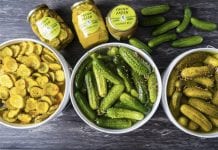By Nancy Chuda founder and Editor in Chief of LuxEcoLiving and co-founder of Healthy Child Healthy World
FDA confirms Listeria outbreak is linked to cantaloupe grown at Colorado farm

Every week we seem to be getting news about our food supply being tainted with dangerous pathogens that have caused serious illness and death.The Internet is faster than the speed of light in reporting these incidents but unfortunately the public is still in harms way.
Yesterday, the Food and Drug Administration confirmed an outbreak of food-borne illnesses that killed four people and sickened nearly three dozen others. All of these incidents were traced to cantaloupe produced at a Colorado farm.
I don’t take chances with my food. I am very diligent about when I buy it and who grows it. I trust my produce selection to a hand full of growers at the Hollywood Farmer’s Market. I know Mr. Finley, one of the best suppliers and are always assured that the quality and the taste live up to CCOF standards.
Sadly, I have learned that Jensen Farms, a family-owned operation, based in Colorado and has been growing cantaloupes for two decades, was the source of contamination of a strain of Listeria. Here is what we know about this uncommon bacteria. It thrives in cool temperatures.
As we have been witness to climate change, we can’t blame this one on Mother Nature. According to Centers for Disease Control and Prevention the incident marks the first time that a Listeria contamination has been linked to whole cantaloupe and one of the few times it has been linked to produce in general. The culprit for this outbreak is refrigeration. It tends to multiply and can spread quickly in damp buildings, dripping off pipes or ceilings onto food.
Listeria may be linked to a simple act of cutting a melon and spreading the bacteria from the surface into the flesh of the melon and then placing the melon back in the refrigerator which prompts the bacteria to grow more quickly.
What becomes even more troublesome is the rate in which it spreads under refrigeration and where it goes. Retailers and wholesalers are at a loss and can’t guarantee that the public is safe. Even the largest grocery store chains not even in close proximity to the area where the bacteria was first cited can assure customers that their melons are safe. Why? “We know who we sell to and who our customers are, but our customers may resell to another company,” said Amy Philpott, a company spokeswoman.
So the giants in the industry like Safeway and Whole Foods may claim that they are not stocking and selling the cantaloupes that may be infected by Listeria but what about the refrigerated trucks that delivered the produce and may contain the silent bacterial killer? Are they to blame?















What about washing the melon thouroughly with soapy water and drying before cutting into? We have all these warnings about bacteria on fruit and salmonella on meat, etc. What can be done to avoid these problems? Doesn’t it help to cook the meat all the way through? The media is always scaring us with these things but never offering any way to counteract or deal with the problem.
The bacteria is apparently _in_ the fruit, not on it, so washing won’t help. Listeria is in soil and can contaminate growing fruit. It’s not from “dripping off pipes” as the author implied, though like any bacteria, Listeria can spread.
And to the author… nowhere does the CDC say it’s because of refrigeration. Please don’t spout nonsense. Listeria can multiply in cooler temperatures, but “refrigerations” is not where this outbreak came from.
And I don’t care if you get your food from your mother, “trusted” sources don’t make any difference. A contaminated melon doesn’t look, smell or taste any different than a normal melon. If Joe Smith in Holly CO was your trusted source, he likely got a local, in-season melon from Jensen farms.
How does the bacteria get INSIDE the melon?? The only possible way is taking an unwashed, dirty melon and cutting into it with a knife and bringing the germs inside the melon with the edge of the knifeblade.
I read a similar story years ago when the CDC was called on a salmonella outbreak and the only food that the infected persons had all eaten was watermelon. Like the cantaloupe, the rind of the watermelon protects the inside from disease. But in the case of the watermelons, they had been sitting in a crate next to a crate of live chickens, with dusty chicken fecal matter floating through the air and coming to rest on the watermelons. When every one of the infected persons cut into their watermelon for a slice, not a single one had washed the outside of the melon before using the knife, and they all became infected with salmonella. Washing and scrubing the rind of a cantaloupe removes the bacteria from the outside.